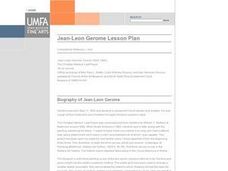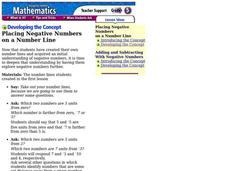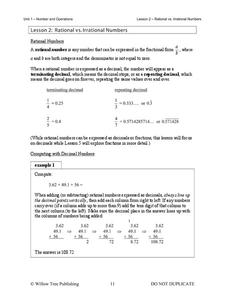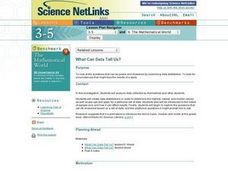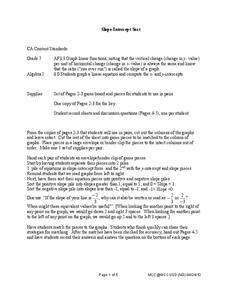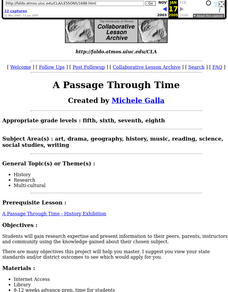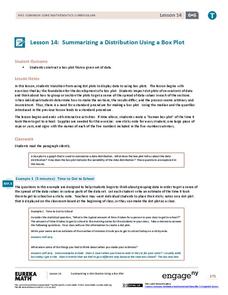Curated OER
Atlatl Lessons for Grade 4
Fourth graders explore the weapons of the Aboriginal people. In this fourth grade math lesson, 4th graders create charts, tables, or diagrams to represent patterns and relations. Students investigate which dart length has the best...
Curated OER
Hidden Values
Students split geode rocks to see that they are beautiful inside. In this geodes lesson plan, students split the geodes and talk about how they have beautiful insides just like people, even if the outsides aren't that pretty.
Curated OER
Chinese New Year: Paper Lanterns Lesson Plan
First graders examine a typical Chinese New Year celebration. As a class, they identify the traditions and values used and discuss how they are unique to China. To end the lesson, they take measurements to make their own paper lantern...
Curated OER
Sense Of Place
Young scholars study ecology, listen to speakers and research conservation topics. In this investigative lesson students discuss wilderness resources, learn about Native Americans and participate in activities that help them to better...
Curated OER
Caribbean Beats and Blends: A Global Sound Lesson
Students listen and respond to various forms of Caribbean music. In this music and culture lesson, students clap rhythms and respond to a sung call. Lyrics are analyzed for language blends and repetition. Music and culture from Puerto...
Curated OER
Jean-Leon Gerome Lesson Plan
Students explore works by French painter Jean-Leon Gerome. In this visual arts instructional activity, students investigate the use of perspective in Gerome's work and then make their own drawings that feature the use of perspective.
Curated OER
Placing Negative Numbers on a Number Line
Students plot numbers on a number line. In this negative numbers lesson plan, students create their own number line. Students discuss the concept of negative numbers and plot some on their number lines. Students create true and false...
Curated OER
Values
Students determine their work values through "The Work Importance Locator Assessment" and discover occupations that match those values.
Curated OER
Creating a Peace Place
Learners, in pairs, explore how to set up and use a "Peace Place," which is a special place to go to center themselves when they are upset or angry.
Curated OER
Hands On: Regroup Tens
In this regrouping tens instructional activity, students use math models or draw pictures to help them add the numbers within the problem. Students also learn to regroup numbers in the tens value place by completing the six problems.
Willow Tree
Rational vs. Irrational Numbers
Build an understanding of rational numbers and their counterpart irrational numbers. Lead learners through an explanation of rational numbers and the ways they can be expressed. Then introduce them to irrational numbers and make...
EngageNY
Find Solutions to Make Equations True
The truth is always best. Individuals continue to find values that make equations true in the 26th installment of the 36-part module. The only difference is that they now call them solutions to those equations.
Education World
Predicting Pumpkins
If you want more pumpkin seeds, you should get a bigger pumpkin—right? Young harvesters use estimation skills to make a hypothesis about how many seeds they will find in a pumpkin before examining the real number inside.
EngageNY
Interpreting Quadratic Functions from Graphs and Tables
Seeing functions in nature is a beautiful part of mathematics by analyzing the motion of a dolphin over time. Then take a look at the value of a stock and maximize the profit of a new toy. Explore the application of quadratics by...
Curated OER
What Can Data Tell Us?
Students explore data distribution. In this data analysis lesson, students create a data distribution table by playing the game "Tower of Hanoi" from the Hall of Science. Students analyze their data and answer data driven questions.
West Contra Costa Unified School District
Slope-Intercept Sort
What's so special about slope? Pupils first match cards with slope and y-intercept to graphs of linear equations. They continue the lesson by matching equations in slope-intercept form to the same graphs.
Curated OER
A Passage Through Time
Young learners research and present information about a chosen subject to their peers, parents, instructors, and community. This lesson has a strong research and public speaking component, and would be ideal for your higher level students.
Curated OER
The Writer’s Toolbox: What You Need to Master the Craft
All the tools (and directions) you’ll need to build an essay are included in a resource designed for learners and educators. The packet can be given to class members or divided into sections and used as part of a series of lesson on the...
EngageNY
Summarizing a Distribution Using a Box Plot
Place the data in a box. Pupils experiment with placing dividers within a data set and discover a need for a systematic method to group the data. The 14th lesson in a series of 22 outlines the procedure for making a box plot based upon...
Curated OER
Creating Climographs
Students use satellite data to compare precipitation and surface temperatures on different islands. In this satellite lesson students create graphs and explain the differences between weather and climate.
Curated OER
"Wedding Celebrations Around The World"
Ninth graders research the cultural implications of wedding celebrations around the world. They study wedding celebrations before creating world map on which they place an appropriately attired wedding couple on the country they studied....
EngageNY
Buying a House
There's no place like home. Future home owners investigate the cost of buying a house in the 33rd installment of a 35-part module. They come to realize that the calculations are simply a variation of previous formulas involving car loans...
Curated OER
Community Helpers
Community Helpers are the focus of this sociology activity. Learners brainstorm the many different jobs done in their community, discuss why they are necessary, and think of ways they can be community helpers.
EngageNY
Why Were Logarithms Developed?
Show your class how people calculated complex math problems in the old days. Scholars take a trip back to the days without calculators in the 15th installment of a 35-part module. They use logarithms to determine products of numbers and...







